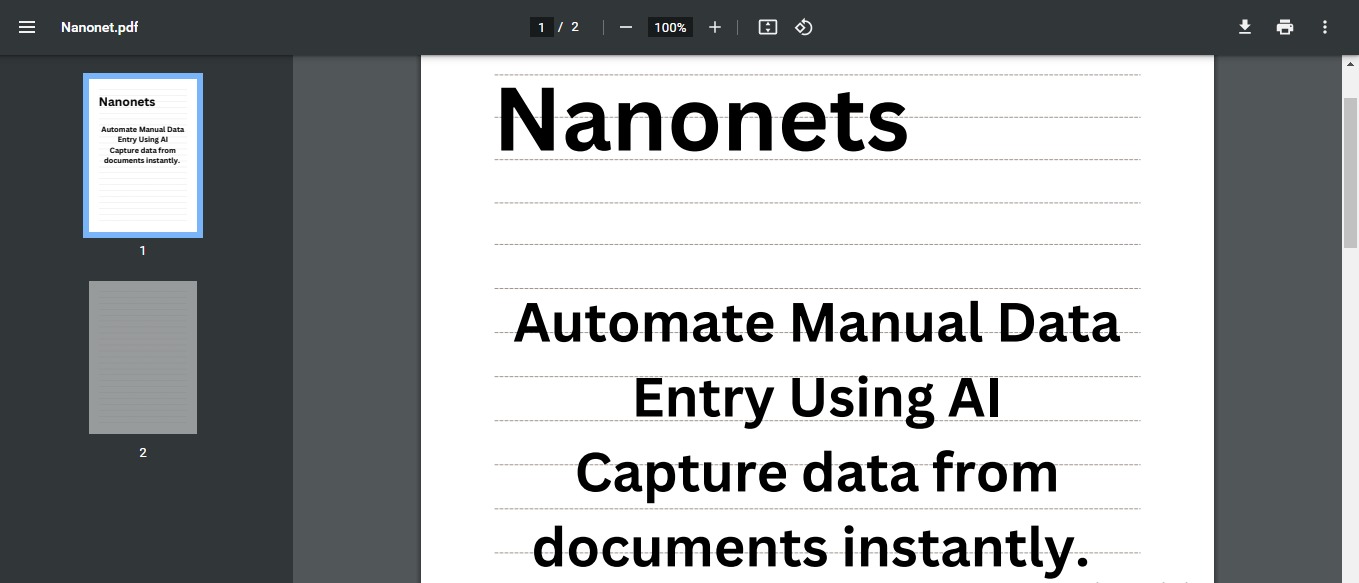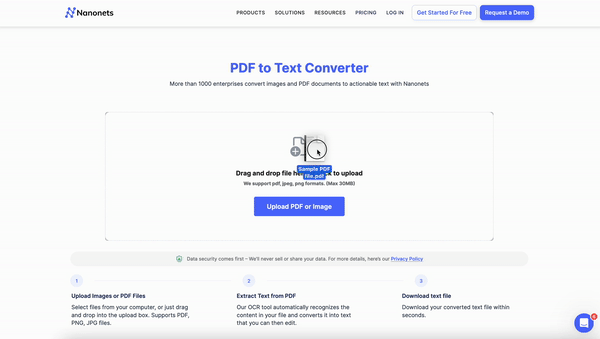Portable Document Format (PDF) files are commonly used to share documents electronically. People and businesses alike use PDF files to share information. We often need to extract some information from PDF files for further processing. However, extracting text from a PDF file can be challenging, especially if the document contains complex formatting and layout. Fortunately, there are several ways to do this.
Here, we will provide the most commonly used method to extract text from PDF files using Python. Python comprises several libraries that allow efficient extraction of PDF text.
The article explores some popular Python libraries for extracting text from PDF files and the step-by-step process of extracting text from PDF files.
Python libraries for PDF processing
Python has several well-integrated libraries that effectively handle unstructured data sources, such as PDFs. Here is a list of some Python libraries for PDF processing.
- pyPDF2: It is a Python library for PDF that can help split, merge, crop and transform pages of PDF files. PyPDF2 also allows you to extract text from PDF files.
- PyMuPDF: PyMuPDF is a Python wrapper for the MuPDF C library. It allows you to read, write, and manipulate PDF files in Python. Also, you can access PDF document metadata, extract text and images, and decrypt a PDF document with PyMuPDF.
- ReportLab: It is an open source Python library that can be used to create and manipulate PDF files. It provides a high-level API to create PDF documents from scratch and supports embedding of images and fonts.
- pdf2dox: It is a Python library for extracting data using the PyMuPDF library from PDF files.
Convert complex PDF files to text format instantly using the PDF to text converter. Try it free.
Setting up the development environment
Before discussing the steps for extracting text from PDF, it is essential to set up a development environment and install the Python libraries needed to extract text.
- Install Python: If you haven’t already, you’ll need to install Python on your system. You can download the latest version of Python from here.
- Install pipe: To check if you have pip installed in Python, run
py -m ensurepip --default-pip If pip doesn’t run automatically, download it here and run the following code to install or update
pip.python get-pip.py- Install the required library: Install any Python library to work with PDF files. Here, we will install the commonly used library, PyPDF2. To install it, run the following command.
pip install PyPDF2Once you’ve installed Python and the required libraries, your development environment is set up. You can use any text editor or IDE to write Python code, such as Visual Studio Code, PyCharm, or Sublime Text.
We will use the Python PyPDF2 library to extract files.
Input PDF:

Production:

Now, let’s understand each code separately.
- reader = PdfReader(‘nanonets.pdf’)
From the PyPDF2 module, we create an object of class PDFReader. It will take the required positional argument from the path to the pdf file.
The pages property provides a List of PageObjects. Here, we can use the Python built-in function len() to get the number of pages in the pdf file.
We can also get a specific pdf file page by touching the page index. List indexing starts at 0 in Python, so this command will give us the first page of the file.
- text = page.extract_text()
print (text)
We will use this command to extract text from the pdf page.
Pre-processing of the extracted text to clean and normalize it
Different preprocessing techniques such as stopword removal, case removal, punctuation removal, stemming, or lemmatization are used to clean and normalize the extracted text in Python.
Input: Python is a popular programming language used for data analysis and machine learning. It is easy to learn and has a wide range of libraries for various applications.
Code:
Production: [‘python,’ ‘popular,’ ‘programming,’ ‘language,’ ‘used,’ ‘data,’ ‘analysis,’ ‘machine,’ ‘learning,’ ‘easy,’ ‘learn,’ ‘wide,’ ‘range,’ ‘libraries,’ ‘various,’ ‘applications’]
This step removed stop words like “is”, “a”, “for”, “and”, “it”, and “has”, and also lowercase all words in the text.
Save extracted text to a file or database
Run the following code:
This code will open a file called extracted_text.txt in writing mode. He f.write() The method writes the preprocessed text to the file. Convert the list of words to clean_text to a string by joining the words with a space character (‘ ‘), then writes the resulting string to the file.
So the result is that the preprocessed text is saved in a file called extracted_text.txt in the current working directory.
Convert complex PDF files to text format instantly using the PDF to text converter. Try it free.

Several advanced techniques can be used to improve the accuracy of text extraction. Here are some techniques:
- Optical Character Recognition (OCR): OCR is a process that converts scanned images into machine-encoded text. OCR can be used to extract text from PDF files that contain images or scanned pages. There are several OCR engines available, including Tesseract, Google Cloud Vision, and Amazon Textract.
- Preprocessing Techniques: Preprocessing techniques involve manipulating the PDF file before the actual extraction process. This includes techniques such as debiasing, denoising, and thresholding to remove noise, bias, and other distortions that can affect the accuracy of the extraction process.
- Design analysis: It involves identifying and classifying the different elements of a PDF file, such as blocks of text, tables, and images. This information can improve the accuracy of text extraction by identifying document structure.
- Machine learning tools: Several text extraction tools, such as Nanonets, use machine learning techniques to accurately extract text from PDF files.
Tips for optimizing performance and reducing memory usage in Python
Efficient memory management in Python can be complex and requires an understanding of Python objects and data structures. Here are some tips to optimize performance and reduce memory usage while running Python code.
1. Use built-in Python libraries and functions
Using Python’s built-in functions is an effective way to speed up your code. It is recommended that you incorporate these functions into your code where appropriate because they are optimized and tested for performance.
These functions are fast because they run in C, a high-performance language. Examples of these functions include max, min, all, map, and many others.
2. Use the Pytorch data loader
Training on a large data set can consume a lot of memory. Using PyTorch’s DataLoader provides a solution to this problem by allowing the creation of multiple mini batches of data from the entire dataset. Each mini batch, which can contain multiple samples determined by available memory, is seamlessly loaded into the model, enabling efficient training of large data sets.
3. Use list comprehension on loops
In Python, loops are common, but list comprehensions offer a more concise and faster way to create new lists. It’s better than the add method for adding items to a Python list.
4. General import declaration expenses
In Python, the location of the import statement can affect the performance and memory usage of your code. Importing a package outside of a function can result in faster code execution, but it can also require more memory than importing the package inside a function. It’s important to consider the tradeoffs between performance and memory usage when deciding where to place import statements in Python.
5. Chunks of data
Chunking, or loading data in small batches, is a useful technique for avoiding out-of-memory errors when working with large data sets in Python. In many cases, not all of the data is needed at once, and attempting to load everything in one batch can cause the program to crash due to memory limitations. By processing the data in smaller chunks, it is possible to avoid these memory errors and save the results as needed. Therefore, data fragmentation is common in data processing and analysis to avoid memory related problems.
6. String concatenation
Two common ways to concatenate strings in Python are to use the ‘+’ operator or the join() method. While the ‘+’ operator is widely used, the join() method is more effective and faster for concatenating strings. The main reason is that at each step, the ‘+’ operator creates a new string and copies the old one, while the join() method works differently, resulting in faster concatenation.
Convert complex PDF files to text format instantly using the PDF to text converter. Try it free.

Carry
Handling memory errors in Python can be challenging, but there are several methods to optimize memory usage and avoid memory overflows. The first step is to identify the root cause of the problem and apply the applicable memory optimization methods. If the problem persists, the related processes can be streamlined or the operation can be broken into smaller parts using an external database service.
With these tips and techniques, it is possible to optimize memory usage and avoid memory-related issues when working with large data sets in Python. While Python libraries offer a convenient way to extract text from PDF files, other automated tools for extracting text, such as Nanonets, are worth considering.






